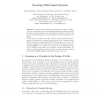28 search results - page 5 / 6 » Economic Hierarchical Q-Learning |
AAAI
2006
13 years 8 months ago
2006
Voting (or rank aggregation) is a general method for aggregating the preferences of multiple agents. One important voting rule is the Slater rule. It selects a ranking of the alte...
ICDCS
2006
IEEE
14 years 1 months ago
2006
IEEE
The Internet is a hierarchical architecture comprising heterogeneous entities of privately owned infrastructures, where higher level Internet service providers (ISPs) supply conne...
AOSE
2005
Springer
14 years 28 days ago
2005
Springer
Abstract Complex systems call for a hierarchical description. Analogously, the engineering of non-trivial MASs (multiagent systems) requires principles and mechanisms for a multi-l...
EMSOFT
2005
Springer
14 years 27 days ago
2005
Springer
The central idea behind interface-based design is to describe components by a component interface. In contrast to a component description that describes what a component does, a c...
CSCW
2010
ACM
14 years 15 days ago
2010
ACM
Online peer-to-peer (P2P) lending organizations enable an individual to obtain an unsecured loan from a collection of individuals without the participation of a bank. Previous res...

